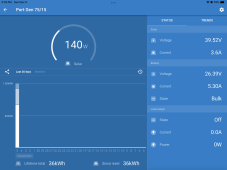ElectroBlvd
New Member
- Joined
- Dec 5, 2021
- Messages
- 13
I have 12x 100w panels running in series 6 parallel 2 going to a Sigineer M3048NC 80a MPPT charge controller. My panels are rated for 18v which gives me 108v with how they are wired. I typically see them running around 103v during peak sun with around 10.8a which is 1,112w. But on the battery side I'm seeing 58.4v with 10.8a which is only 630w. Am I wrong in how I understood a MPPT controller works? Shouldn't I be getting more around 19a to the batteries? My understanding was a PWM controller would lower the voltage to match your batteries so you would lose a lot of the power produced but an MPPT controller would essentially lower voltage and raise amperage to get closer to the max wattage the panels are providing so you're losing less power produced. But I'm not seeing that.
Panel Specs:
18v, 5.56a, 22.5v Voc, 5.81a Isc
Panel Specs:
18v, 5.56a, 22.5v Voc, 5.81a Isc



